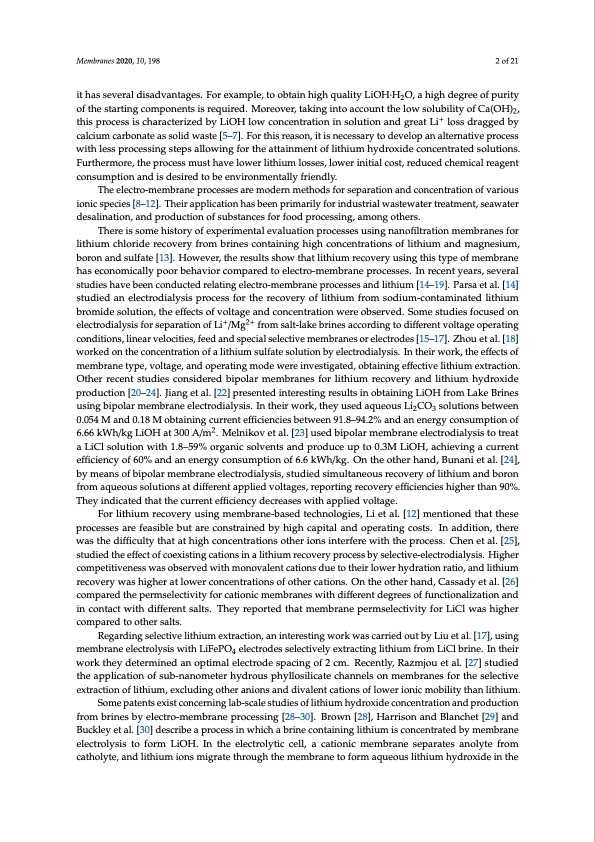
PDF Publication Title:
Text from PDF Page: 002
Membranes 2020, 10, 198 2 of 21 it has several disadvantages. For example, to obtain high quality LiOH·H2O, a high degree of purity of the starting components is required. Moreover, taking into account the low solubility of Ca(OH)2, this process is characterized by LiOH low concentration in solution and great Li+ loss dragged by calcium carbonate as solid waste [5–7]. For this reason, it is necessary to develop an alternative process with less processing steps allowing for the attainment of lithium hydroxide concentrated solutions. Furthermore, the process must have lower lithium losses, lower initial cost, reduced chemical reagent consumption and is desired to be environmentally friendly. The electro-membrane processes are modern methods for separation and concentration of various ionic species [8–12]. Their application has been primarily for industrial wastewater treatment, seawater desalination, and production of substances for food processing, among others. There is some history of experimental evaluation processes using nanofiltration membranes for lithium chloride recovery from brines containing high concentrations of lithium and magnesium, boron and sulfate [13]. However, the results show that lithium recovery using this type of membrane has economically poor behavior compared to electro-membrane processes. In recent years, several studies have been conducted relating electro-membrane processes and lithium [14–19]. Parsa et al. [14] studied an electrodialysis process for the recovery of lithium from sodium-contaminated lithium bromide solution, the effects of voltage and concentration were observed. Some studies focused on electrodialysis for separation of Li+/Mg2+ from salt-lake brines according to different voltage operating conditions, linear velocities, feed and special selective membranes or electrodes [15–17]. Zhou et al. [18] worked on the concentration of a lithium sulfate solution by electrodialysis. In their work, the effects of membrane type, voltage, and operating mode were investigated, obtaining effective lithium extraction. Other recent studies considered bipolar membranes for lithium recovery and lithium hydroxide production [20–24]. Jiang et al. [22] presented interesting results in obtaining LiOH from Lake Brines using bipolar membrane electrodialysis. In their work, they used aqueous Li2CO3 solutions between 0.054 M and 0.18 M obtaining current efficiencies between 91.8–94.2% and an energy consumption of 6.66 kWh/kg LiOH at 300 A/m2. Melnikov et al. [23] used bipolar membrane electrodialysis to treat a LiCl solution with 1.8–59% organic solvents and produce up to 0.3M LiOH, achieving a current efficiency of 60% and an energy consumption of 6.6 kWh/kg. On the other hand, Bunani et al. [24], by means of bipolar membrane electrodialysis, studied simultaneous recovery of lithium and boron from aqueous solutions at different applied voltages, reporting recovery efficiencies higher than 90%. They indicated that the current efficiency decreases with applied voltage. For lithium recovery using membrane-based technologies, Li et al. [12] mentioned that these processes are feasible but are constrained by high capital and operating costs. In addition, there was the difficulty that at high concentrations other ions interfere with the process. Chen et al. [25], studied the effect of coexisting cations in a lithium recovery process by selective-electrodialysis. Higher competitiveness was observed with monovalent cations due to their lower hydration ratio, and lithium recovery was higher at lower concentrations of other cations. On the other hand, Cassady et al. [26] compared the permselectivity for cationic membranes with different degrees of functionalization and in contact with different salts. They reported that membrane permselectivity for LiCl was higher compared to other salts. Regarding selective lithium extraction, an interesting work was carried out by Liu et al. [17], using membrane electrolysis with LiFePO4 electrodes selectively extracting lithium from LiCl brine. In their work they determined an optimal electrode spacing of 2 cm. Recently, Razmjou et al. [27] studied the application of sub-nanometer hydrous phyllosilicate channels on membranes for the selective extraction of lithium, excluding other anions and divalent cations of lower ionic mobility than lithium. Some patents exist concerning lab-scale studies of lithium hydroxide concentration and production from brines by electro-membrane processing [28–30]. Brown [28], Harrison and Blanchet [29] and Buckley et al. [30] describe a process in which a brine containing lithium is concentrated by membrane electrolysis to form LiOH. In the electrolytic cell, a cationic membrane separates anolyte from catholyte, and lithium ions migrate through the membrane to form aqueous lithium hydroxide in thePDF Image | Battery Grade Li Hydroxide by Membrane Electrodialysis

PDF Search Title:
Battery Grade Li Hydroxide by Membrane ElectrodialysisOriginal File Name Searched:
membranes-10-00198.pdfDIY PDF Search: Google It | Yahoo | Bing
Product and Development Focus for Infinity Turbine
ORC Waste Heat Turbine and ORC System Build Plans: All turbine plans are $10,000 each. This allows you to build a system and then consider licensing for production after you have completed and tested a unit.Redox Flow Battery Technology: With the advent of the new USA tax credits for producing and selling batteries ($35/kW) we are focussing on a simple flow battery using shipping containers as the modular electrolyte storage units with tax credits up to $140,000 per system. Our main focus is on the salt battery. This battery can be used for both thermal and electrical storage applications. We call it the Cogeneration Battery or Cogen Battery. One project is converting salt (brine) based water conditioners to simultaneously produce power. In addition, there are many opportunities to extract Lithium from brine (salt lakes, groundwater, and producer water).Salt water or brine are huge sources for lithium. Most of the worlds lithium is acquired from a brine source. It's even in seawater in a low concentration. Brine is also a byproduct of huge powerplants, which can now use that as an electrolyte and a huge flow battery (which allows storage at the source).We welcome any business and equipment inquiries, as well as licensing our turbines for manufacturing.| CONTACT TEL: 608-238-6001 Email: greg@infinityturbine.com | RSS | AMP |